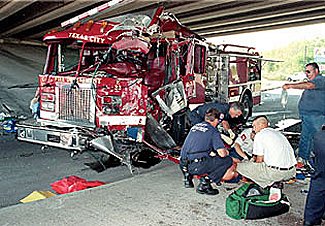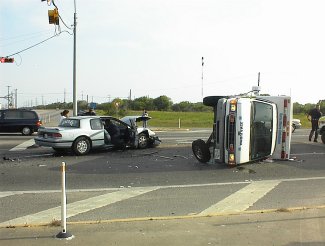FAILURE TO YIELD
Written by Mark Pandanell
Webmaster
|
Failure to yield resulted in the loss of a Firefighters life and the loss of a brand new fire truck.
|
|
Failure to yield the right of way to Emergency Vehicles as they are responding to calls these days is becoming a common occurrence. It seems that more people than not are just in too much of a hurry to get to where they are going and refuse to take the few seconds to let an emergency vehicle pass. It should be noted, that most drivers just do not know what to do when they encounter an emergency vehicle with its emergency lights and sirens turned on.
Over the past 8 years that I have been a firefighter, I have seen countless drivers who refused to yield to us for one reason or another. At times it is intentional and at times it is not. A driver not paying attention to their surroundings is the main reason for not yielding. As a driver approaches an intersection with the green light facing them and notices that other vehicles in the lanes have stopped for the green light, this should be an indication that something is happening at this intersection. Time and time again though, the driver will continue through the intersection even if they have to change lanes to move around the stopped vehicles. Then they notice that there is an emergency vehicle trying to cross the intersection, though sometimes they are oblivious to what's going on and never realize that they should have yielded to a fire truck. The reason for not yielding can also be a cell phone. If they are holding the phone on their right ear and the fire truck is approaching on the right, then they will most likely never see or hear the fire truck. Some of the reasons for not hearing the sirens on a fire truck would be how vehicles are designed these days. Vehicles are being designed to be as sound proof as possible. Also having the radio turned up too loud and as I have mentioned before, talking on the cell phone. Combine all these together, which does happen often, and drivers will never hear or see any emergency vehicles.
Firefighters are trained on how to approach an intersection and there are even rules and regulations on this. Intersections are dangerous places for a fire truck as the firefighters respond to emergency calls. Extreme caution should be heeded at the intersection whether the fire truck has the red or green light. Fire truck drivers should always come to a complete stop at any red light and proceed only if and when all vehicles are at a complete stop. They should also approach an intersection with a green light with extreme caution. Not following these rules at every intersection could lead to disaster. Texas City Fire lost a Captain and a fire truck in October 1999. The driver of the fire truck was also injured badly enough that he is no longer working as a firefighter. The rules were not followed on both sides and the results were tragic. Click here for the official report on this accident.
Not all encounters between fire trucks and civilian owned vehicles happen at intersections. Drivers are passing up fire trucks at an alarming rate. As the fire truck responds to an emergency, civilian drivers will pass up the fire truck on the left or right side. This puts everyone at risk, as the driver has no idea as to what the fire truck is about to do, be it making a left or right turn. This is as dangerous as it gets, especially as the speed of both vehicles increase. Even as the fire truck sounds its loud air horn, the driver never looks as he passes. Some fire personnel have even said that the drivers have made rude gestures toward them as they go by as if they had a right to pass the fire truck with its emergency lights and sirens turned on. Passing a fire truck as it responds to an emergency is not only illegal but shows great disrespect for the fire department and the people in need they are responding to.
As the fire truck approaches from behind with its emergency lights and sirens on, most drivers are not sure on what to do. This is especially true if the driver does not notice the emergency vehicle until it is right up behind them. This is when people panic or become totally confused on what to do. Drivers will pull over to the left and stop. They will speed up, as if staying ahead of the emergency vehicle until they get to where they were going to, will make it all right. They will pull over to the right but still proceed down the road at a slow pace. Proceeding down the road at a slow pace also takes place as they pull over to the left at times. Some drivers are so startled when they finally notice an emergency vehicle behind them, that they will stop right in front of the emergency vehicle. Drivers will pull right out in front of emergency vehicles from either a cross street or a parking lot only to realize what they have done and then try to pull over out of the way. This shows that they were not looking for any traffic that might have been coming down the road in the first place. With all of this and more happening during an emergency response, emergency vehicle drivers should never try to predetermine how a civilian driver will react.
Once the fire trucks get on scene, not only do the firefighters have to concentrate on the work at hand, they always have to be on the look out for vehicles trying to negotiate through the scene. Even with police officers directing traffic, someone always manages to get through and drive into an emergency scene. At house fires, drivers will run over hoses, equipment and anything else that might be in their way or slow them down. They will even drive through yards to get through. The same goes for vehicle accident scenes. The driver is so busy trying to see what's going on, that they do not pay attention to where their vehicle is headed. Firefighters have been injured and even killed because the driver of the vehicle was not paying attention to their speed or to where the vehicle was going. People love to "rubberneck" at accident scenes and more often than not, they usually cause the next accident. Allot of drivers get totally confused when they approach an accident scene with all the lights flashing and personnel everywhere. They see an opening and go through it, not realizing that it is in the middle of the accident scene. They think that as long as there is an opening and they proceed slowly then it is ok, no matter how close it takes them to the scene. It is as if they are in such a hurry to get to their destination, or that they are just totally confused on what to do as they approach. Firefighters also have to watch out for the drivers that insist on doing the speed limit, even if it is 65mph, by the scene the firefighters are working. These drivers are especially dangerous. There are always a few of them coming through.
With so many vehicles on the roadways today and with the emergency personnel responding to emergency situations everywhere, this is where the training becomes important for the fire personnel. Fire departments should have an ongoing driver-training program. Fire personnel drivers should also follow the Rules and Regulations of their departments. All fire personnel should be trained to be on the lookout for vehicles at any scene that involves a roadway of any type.
Civilian drivers should also follow the laws that pertain to them as they encounter an emergency vehicle responding to calls. As a driver, when you first hear the sirens, you should immediately look to pull over to the right and come to a complete stop. When you first see the emergency vehicle coming up behind you with emergency flashing lights, immediately pull over to the right and stop. Make sure you come to a complete stop and not continue down the road at a slow pace, as the emergency vehicle might have to turn right soon. Do not speed up to try and stay ahead of the emergency vehicle thinking that you can hurry up and make your turn to get to where you were going. As you approach an intersection and you notice everyone else is stopped for a green light, slow down and stop. They are not all stopping just to wait on you to proceed through and take the lead. NEVER try to beat a fire truck through the intersection!
Remember, the few seconds it will take for you as a responsible driver to yield to an emergency vehicle, will be worth it for yourself, the firefighters and the citizens they are responding to. Someday it might be you, a family member or a friend in need that the firefighters are trying to respond to.

